Report: How Media Coverage of Traumatic Events Affects Individuals
VerifiedAdded on 2023/01/12
|8
|2305
|57
Report
AI Summary
This report investigates the psychological effects of media coverage on individuals exposed to traumatic events. It examines the link between media consumption and increased rates of acute stress disorder, post-traumatic stress disorder (PTSD), and depression. The report analyzes various cases, including the Oklahoma City bombing, the Gulf War, and the September 11 attacks, to illustrate how media exposure can worsen stress symptoms, especially in children. It also discusses the role of social media in amplifying these effects, as seen in the Boston Marathon bombing. The report acknowledges both the positive and negative aspects of media coverage, such as providing information and support, while also highlighting the potential for increased anxiety and psychological distress. The conclusion emphasizes the need for controlled media consumption to mitigate the negative impacts of traumatic events, and the recommendations suggest further research using current articles, secondary research and content analysis to get accurate results and assess the impact of media on mental health.
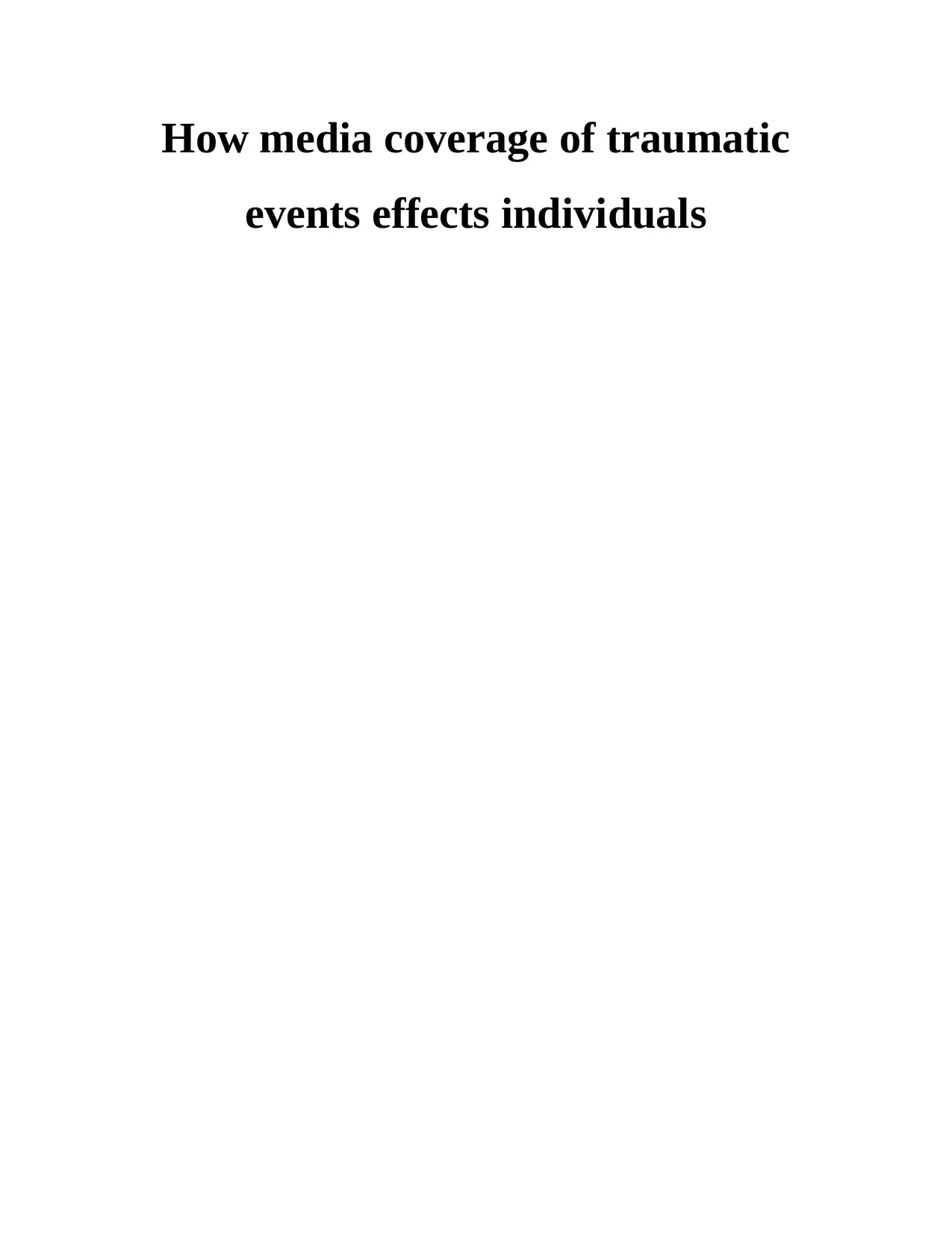
How media coverage of traumatic
events effects individuals
events effects individuals
Secure Best Marks with AI Grader
Need help grading? Try our AI Grader for instant feedback on your assignments.
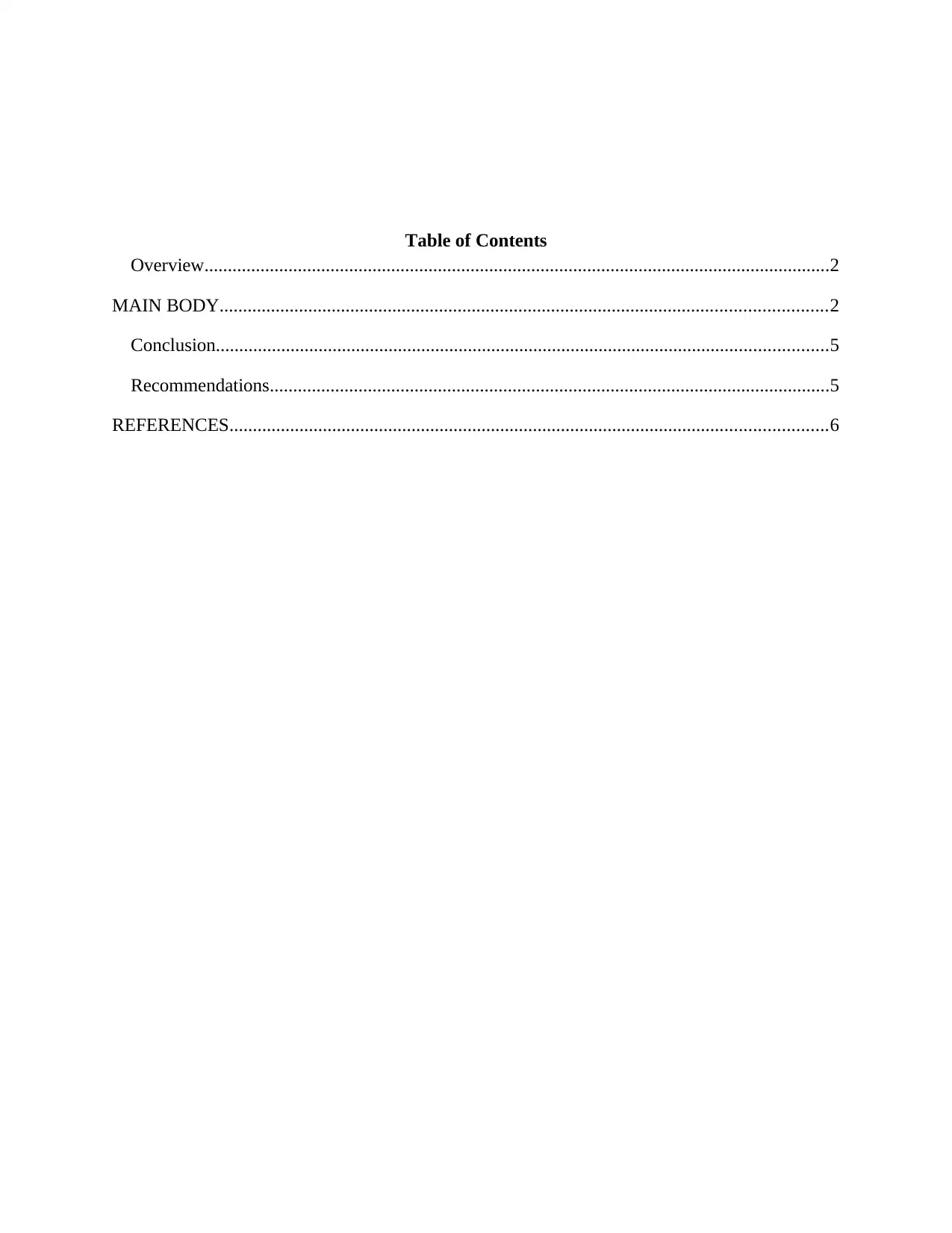
Table of Contents
Overview......................................................................................................................................2
MAIN BODY..................................................................................................................................2
Conclusion...................................................................................................................................5
Recommendations........................................................................................................................5
REFERENCES................................................................................................................................6
Overview......................................................................................................................................2
MAIN BODY..................................................................................................................................2
Conclusion...................................................................................................................................5
Recommendations........................................................................................................................5
REFERENCES................................................................................................................................6
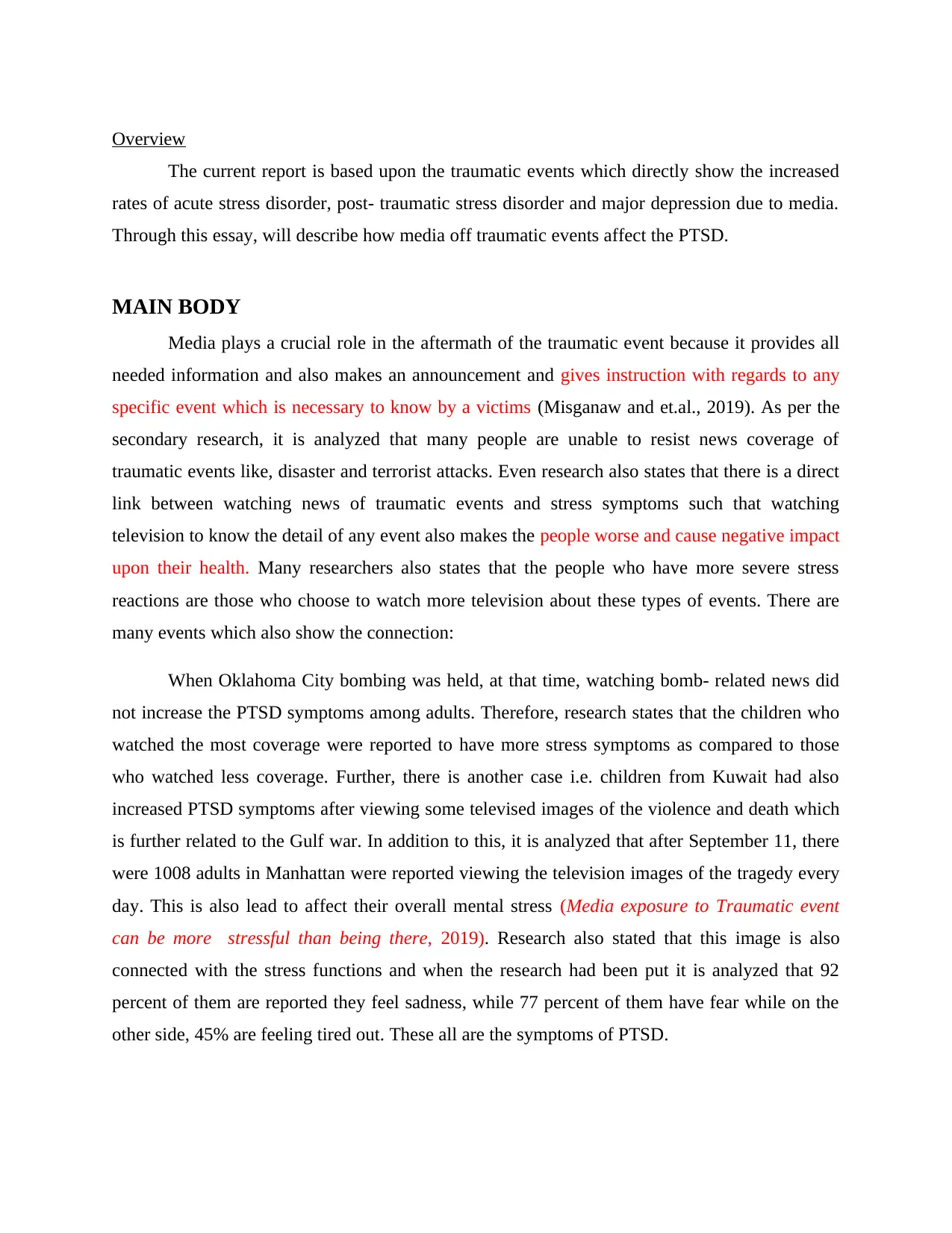
Overview
The current report is based upon the traumatic events which directly show the increased
rates of acute stress disorder, post- traumatic stress disorder and major depression due to media.
Through this essay, will describe how media off traumatic events affect the PTSD.
MAIN BODY
Media plays a crucial role in the aftermath of the traumatic event because it provides all
needed information and also makes an announcement and gives instruction with regards to any
specific event which is necessary to know by a victims (Misganaw and et.al., 2019). As per the
secondary research, it is analyzed that many people are unable to resist news coverage of
traumatic events like, disaster and terrorist attacks. Even research also states that there is a direct
link between watching news of traumatic events and stress symptoms such that watching
television to know the detail of any event also makes the people worse and cause negative impact
upon their health. Many researchers also states that the people who have more severe stress
reactions are those who choose to watch more television about these types of events. There are
many events which also show the connection:
When Oklahoma City bombing was held, at that time, watching bomb- related news did
not increase the PTSD symptoms among adults. Therefore, research states that the children who
watched the most coverage were reported to have more stress symptoms as compared to those
who watched less coverage. Further, there is another case i.e. children from Kuwait had also
increased PTSD symptoms after viewing some televised images of the violence and death which
is further related to the Gulf war. In addition to this, it is analyzed that after September 11, there
were 1008 adults in Manhattan were reported viewing the television images of the tragedy every
day. This is also lead to affect their overall mental stress (Media exposure to Traumatic event
can be more stressful than being there, 2019). Research also stated that this image is also
connected with the stress functions and when the research had been put it is analyzed that 92
percent of them are reported they feel sadness, while 77 percent of them have fear while on the
other side, 45% are feeling tired out. These all are the symptoms of PTSD.
The current report is based upon the traumatic events which directly show the increased
rates of acute stress disorder, post- traumatic stress disorder and major depression due to media.
Through this essay, will describe how media off traumatic events affect the PTSD.
MAIN BODY
Media plays a crucial role in the aftermath of the traumatic event because it provides all
needed information and also makes an announcement and gives instruction with regards to any
specific event which is necessary to know by a victims (Misganaw and et.al., 2019). As per the
secondary research, it is analyzed that many people are unable to resist news coverage of
traumatic events like, disaster and terrorist attacks. Even research also states that there is a direct
link between watching news of traumatic events and stress symptoms such that watching
television to know the detail of any event also makes the people worse and cause negative impact
upon their health. Many researchers also states that the people who have more severe stress
reactions are those who choose to watch more television about these types of events. There are
many events which also show the connection:
When Oklahoma City bombing was held, at that time, watching bomb- related news did
not increase the PTSD symptoms among adults. Therefore, research states that the children who
watched the most coverage were reported to have more stress symptoms as compared to those
who watched less coverage. Further, there is another case i.e. children from Kuwait had also
increased PTSD symptoms after viewing some televised images of the violence and death which
is further related to the Gulf war. In addition to this, it is analyzed that after September 11, there
were 1008 adults in Manhattan were reported viewing the television images of the tragedy every
day. This is also lead to affect their overall mental stress (Media exposure to Traumatic event
can be more stressful than being there, 2019). Research also stated that this image is also
connected with the stress functions and when the research had been put it is analyzed that 92
percent of them are reported they feel sadness, while 77 percent of them have fear while on the
other side, 45% are feeling tired out. These all are the symptoms of PTSD.
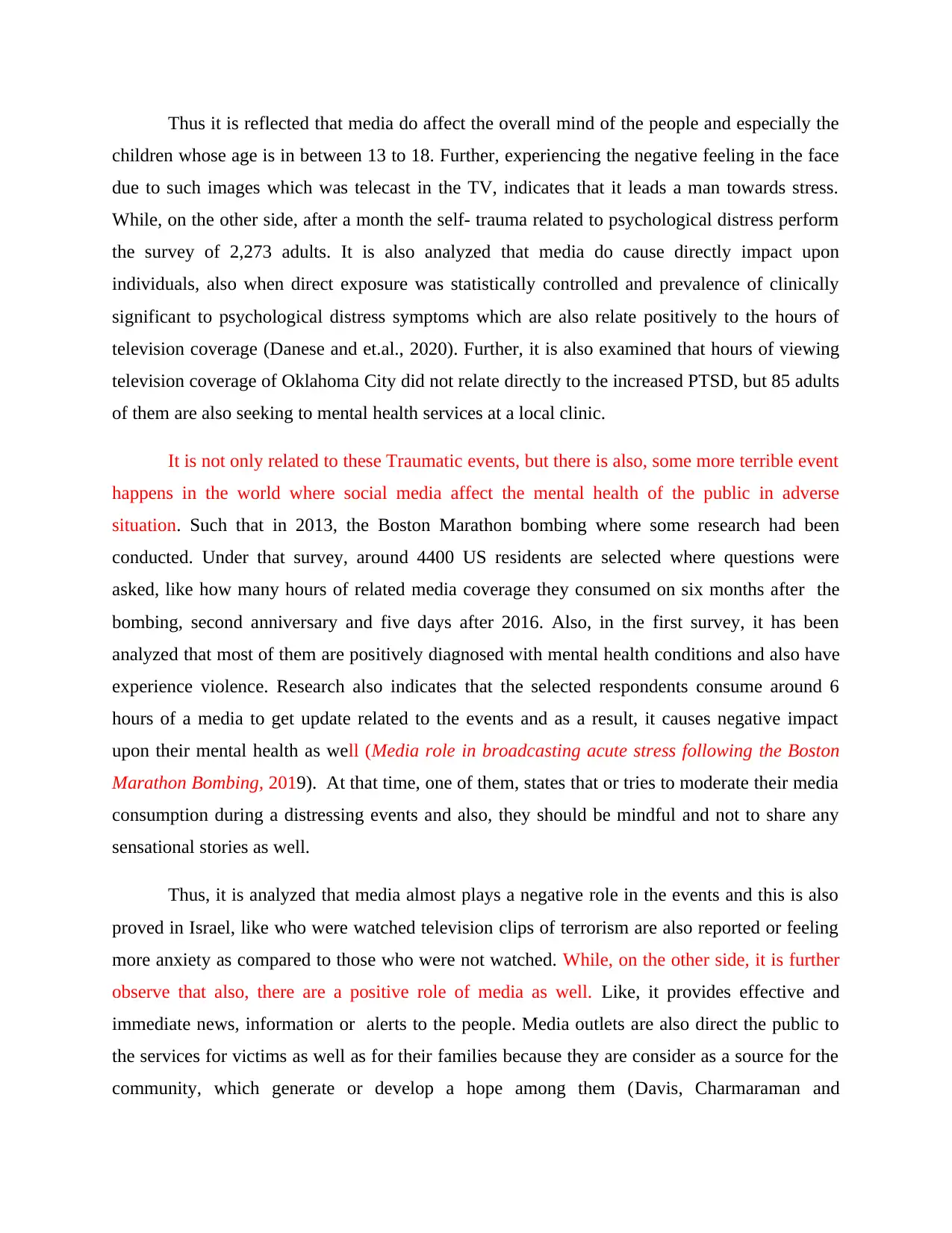
Thus it is reflected that media do affect the overall mind of the people and especially the
children whose age is in between 13 to 18. Further, experiencing the negative feeling in the face
due to such images which was telecast in the TV, indicates that it leads a man towards stress.
While, on the other side, after a month the self- trauma related to psychological distress perform
the survey of 2,273 adults. It is also analyzed that media do cause directly impact upon
individuals, also when direct exposure was statistically controlled and prevalence of clinically
significant to psychological distress symptoms which are also relate positively to the hours of
television coverage (Danese and et.al., 2020). Further, it is also examined that hours of viewing
television coverage of Oklahoma City did not relate directly to the increased PTSD, but 85 adults
of them are also seeking to mental health services at a local clinic.
It is not only related to these Traumatic events, but there is also, some more terrible event
happens in the world where social media affect the mental health of the public in adverse
situation. Such that in 2013, the Boston Marathon bombing where some research had been
conducted. Under that survey, around 4400 US residents are selected where questions were
asked, like how many hours of related media coverage they consumed on six months after the
bombing, second anniversary and five days after 2016. Also, in the first survey, it has been
analyzed that most of them are positively diagnosed with mental health conditions and also have
experience violence. Research also indicates that the selected respondents consume around 6
hours of a media to get update related to the events and as a result, it causes negative impact
upon their mental health as well (Media role in broadcasting acute stress following the Boston
Marathon Bombing, 2019). At that time, one of them, states that or tries to moderate their media
consumption during a distressing events and also, they should be mindful and not to share any
sensational stories as well.
Thus, it is analyzed that media almost plays a negative role in the events and this is also
proved in Israel, like who were watched television clips of terrorism are also reported or feeling
more anxiety as compared to those who were not watched. While, on the other side, it is further
observe that also, there are a positive role of media as well. Like, it provides effective and
immediate news, information or alerts to the people. Media outlets are also direct the public to
the services for victims as well as for their families because they are consider as a source for the
community, which generate or develop a hope among them (Davis, Charmaraman and
children whose age is in between 13 to 18. Further, experiencing the negative feeling in the face
due to such images which was telecast in the TV, indicates that it leads a man towards stress.
While, on the other side, after a month the self- trauma related to psychological distress perform
the survey of 2,273 adults. It is also analyzed that media do cause directly impact upon
individuals, also when direct exposure was statistically controlled and prevalence of clinically
significant to psychological distress symptoms which are also relate positively to the hours of
television coverage (Danese and et.al., 2020). Further, it is also examined that hours of viewing
television coverage of Oklahoma City did not relate directly to the increased PTSD, but 85 adults
of them are also seeking to mental health services at a local clinic.
It is not only related to these Traumatic events, but there is also, some more terrible event
happens in the world where social media affect the mental health of the public in adverse
situation. Such that in 2013, the Boston Marathon bombing where some research had been
conducted. Under that survey, around 4400 US residents are selected where questions were
asked, like how many hours of related media coverage they consumed on six months after the
bombing, second anniversary and five days after 2016. Also, in the first survey, it has been
analyzed that most of them are positively diagnosed with mental health conditions and also have
experience violence. Research also indicates that the selected respondents consume around 6
hours of a media to get update related to the events and as a result, it causes negative impact
upon their mental health as well (Media role in broadcasting acute stress following the Boston
Marathon Bombing, 2019). At that time, one of them, states that or tries to moderate their media
consumption during a distressing events and also, they should be mindful and not to share any
sensational stories as well.
Thus, it is analyzed that media almost plays a negative role in the events and this is also
proved in Israel, like who were watched television clips of terrorism are also reported or feeling
more anxiety as compared to those who were not watched. While, on the other side, it is further
observe that also, there are a positive role of media as well. Like, it provides effective and
immediate news, information or alerts to the people. Media outlets are also direct the public to
the services for victims as well as for their families because they are consider as a source for the
community, which generate or develop a hope among them (Davis, Charmaraman and
Secure Best Marks with AI Grader
Need help grading? Try our AI Grader for instant feedback on your assignments.
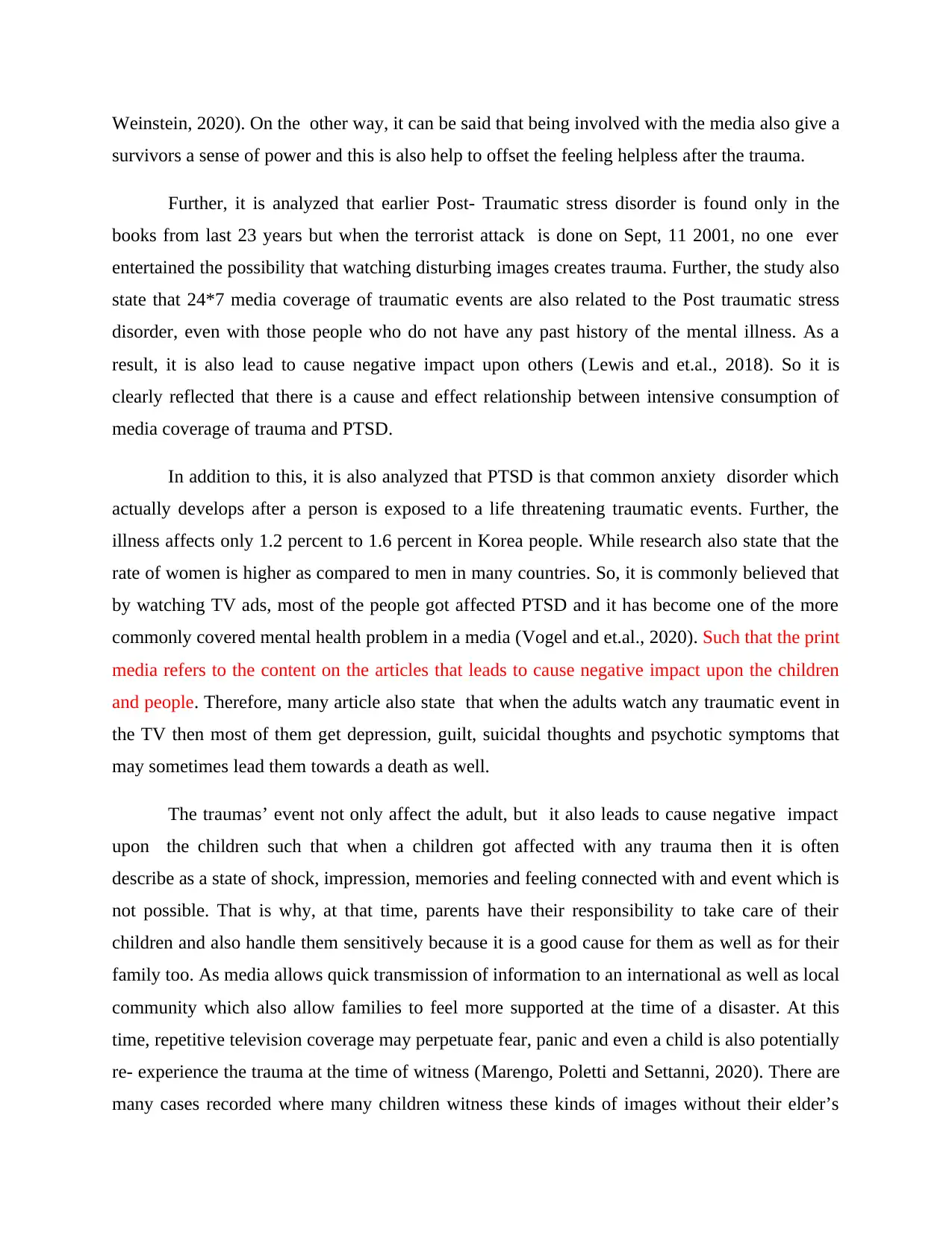
Weinstein, 2020). On the other way, it can be said that being involved with the media also give a
survivors a sense of power and this is also help to offset the feeling helpless after the trauma.
Further, it is analyzed that earlier Post- Traumatic stress disorder is found only in the
books from last 23 years but when the terrorist attack is done on Sept, 11 2001, no one ever
entertained the possibility that watching disturbing images creates trauma. Further, the study also
state that 24*7 media coverage of traumatic events are also related to the Post traumatic stress
disorder, even with those people who do not have any past history of the mental illness. As a
result, it is also lead to cause negative impact upon others (Lewis and et.al., 2018). So it is
clearly reflected that there is a cause and effect relationship between intensive consumption of
media coverage of trauma and PTSD.
In addition to this, it is also analyzed that PTSD is that common anxiety disorder which
actually develops after a person is exposed to a life threatening traumatic events. Further, the
illness affects only 1.2 percent to 1.6 percent in Korea people. While research also state that the
rate of women is higher as compared to men in many countries. So, it is commonly believed that
by watching TV ads, most of the people got affected PTSD and it has become one of the more
commonly covered mental health problem in a media (Vogel and et.al., 2020). Such that the print
media refers to the content on the articles that leads to cause negative impact upon the children
and people. Therefore, many article also state that when the adults watch any traumatic event in
the TV then most of them get depression, guilt, suicidal thoughts and psychotic symptoms that
may sometimes lead them towards a death as well.
The traumas’ event not only affect the adult, but it also leads to cause negative impact
upon the children such that when a children got affected with any trauma then it is often
describe as a state of shock, impression, memories and feeling connected with and event which is
not possible. That is why, at that time, parents have their responsibility to take care of their
children and also handle them sensitively because it is a good cause for them as well as for their
family too. As media allows quick transmission of information to an international as well as local
community which also allow families to feel more supported at the time of a disaster. At this
time, repetitive television coverage may perpetuate fear, panic and even a child is also potentially
re- experience the trauma at the time of witness (Marengo, Poletti and Settanni, 2020). There are
many cases recorded where many children witness these kinds of images without their elder’s
survivors a sense of power and this is also help to offset the feeling helpless after the trauma.
Further, it is analyzed that earlier Post- Traumatic stress disorder is found only in the
books from last 23 years but when the terrorist attack is done on Sept, 11 2001, no one ever
entertained the possibility that watching disturbing images creates trauma. Further, the study also
state that 24*7 media coverage of traumatic events are also related to the Post traumatic stress
disorder, even with those people who do not have any past history of the mental illness. As a
result, it is also lead to cause negative impact upon others (Lewis and et.al., 2018). So it is
clearly reflected that there is a cause and effect relationship between intensive consumption of
media coverage of trauma and PTSD.
In addition to this, it is also analyzed that PTSD is that common anxiety disorder which
actually develops after a person is exposed to a life threatening traumatic events. Further, the
illness affects only 1.2 percent to 1.6 percent in Korea people. While research also state that the
rate of women is higher as compared to men in many countries. So, it is commonly believed that
by watching TV ads, most of the people got affected PTSD and it has become one of the more
commonly covered mental health problem in a media (Vogel and et.al., 2020). Such that the print
media refers to the content on the articles that leads to cause negative impact upon the children
and people. Therefore, many article also state that when the adults watch any traumatic event in
the TV then most of them get depression, guilt, suicidal thoughts and psychotic symptoms that
may sometimes lead them towards a death as well.
The traumas’ event not only affect the adult, but it also leads to cause negative impact
upon the children such that when a children got affected with any trauma then it is often
describe as a state of shock, impression, memories and feeling connected with and event which is
not possible. That is why, at that time, parents have their responsibility to take care of their
children and also handle them sensitively because it is a good cause for them as well as for their
family too. As media allows quick transmission of information to an international as well as local
community which also allow families to feel more supported at the time of a disaster. At this
time, repetitive television coverage may perpetuate fear, panic and even a child is also potentially
re- experience the trauma at the time of witness (Marengo, Poletti and Settanni, 2020). There are
many cases recorded where many children witness these kinds of images without their elder’s
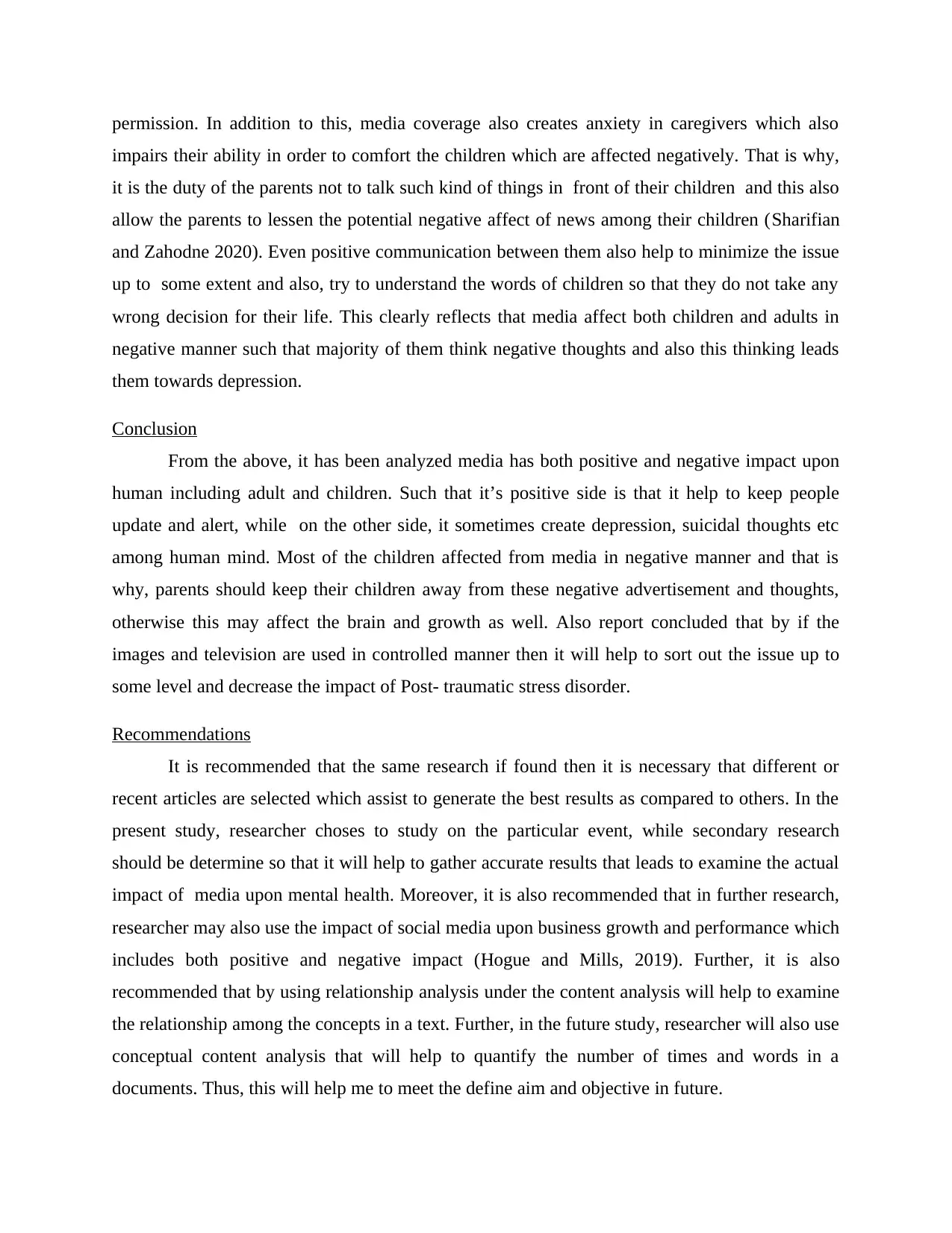
permission. In addition to this, media coverage also creates anxiety in caregivers which also
impairs their ability in order to comfort the children which are affected negatively. That is why,
it is the duty of the parents not to talk such kind of things in front of their children and this also
allow the parents to lessen the potential negative affect of news among their children (Sharifian
and Zahodne 2020). Even positive communication between them also help to minimize the issue
up to some extent and also, try to understand the words of children so that they do not take any
wrong decision for their life. This clearly reflects that media affect both children and adults in
negative manner such that majority of them think negative thoughts and also this thinking leads
them towards depression.
Conclusion
From the above, it has been analyzed media has both positive and negative impact upon
human including adult and children. Such that it’s positive side is that it help to keep people
update and alert, while on the other side, it sometimes create depression, suicidal thoughts etc
among human mind. Most of the children affected from media in negative manner and that is
why, parents should keep their children away from these negative advertisement and thoughts,
otherwise this may affect the brain and growth as well. Also report concluded that by if the
images and television are used in controlled manner then it will help to sort out the issue up to
some level and decrease the impact of Post- traumatic stress disorder.
Recommendations
It is recommended that the same research if found then it is necessary that different or
recent articles are selected which assist to generate the best results as compared to others. In the
present study, researcher choses to study on the particular event, while secondary research
should be determine so that it will help to gather accurate results that leads to examine the actual
impact of media upon mental health. Moreover, it is also recommended that in further research,
researcher may also use the impact of social media upon business growth and performance which
includes both positive and negative impact (Hogue and Mills, 2019). Further, it is also
recommended that by using relationship analysis under the content analysis will help to examine
the relationship among the concepts in a text. Further, in the future study, researcher will also use
conceptual content analysis that will help to quantify the number of times and words in a
documents. Thus, this will help me to meet the define aim and objective in future.
impairs their ability in order to comfort the children which are affected negatively. That is why,
it is the duty of the parents not to talk such kind of things in front of their children and this also
allow the parents to lessen the potential negative affect of news among their children (Sharifian
and Zahodne 2020). Even positive communication between them also help to minimize the issue
up to some extent and also, try to understand the words of children so that they do not take any
wrong decision for their life. This clearly reflects that media affect both children and adults in
negative manner such that majority of them think negative thoughts and also this thinking leads
them towards depression.
Conclusion
From the above, it has been analyzed media has both positive and negative impact upon
human including adult and children. Such that it’s positive side is that it help to keep people
update and alert, while on the other side, it sometimes create depression, suicidal thoughts etc
among human mind. Most of the children affected from media in negative manner and that is
why, parents should keep their children away from these negative advertisement and thoughts,
otherwise this may affect the brain and growth as well. Also report concluded that by if the
images and television are used in controlled manner then it will help to sort out the issue up to
some level and decrease the impact of Post- traumatic stress disorder.
Recommendations
It is recommended that the same research if found then it is necessary that different or
recent articles are selected which assist to generate the best results as compared to others. In the
present study, researcher choses to study on the particular event, while secondary research
should be determine so that it will help to gather accurate results that leads to examine the actual
impact of media upon mental health. Moreover, it is also recommended that in further research,
researcher may also use the impact of social media upon business growth and performance which
includes both positive and negative impact (Hogue and Mills, 2019). Further, it is also
recommended that by using relationship analysis under the content analysis will help to examine
the relationship among the concepts in a text. Further, in the future study, researcher will also use
conceptual content analysis that will help to quantify the number of times and words in a
documents. Thus, this will help me to meet the define aim and objective in future.

Paraphrase This Document
Need a fresh take? Get an instant paraphrase of this document with our AI Paraphraser
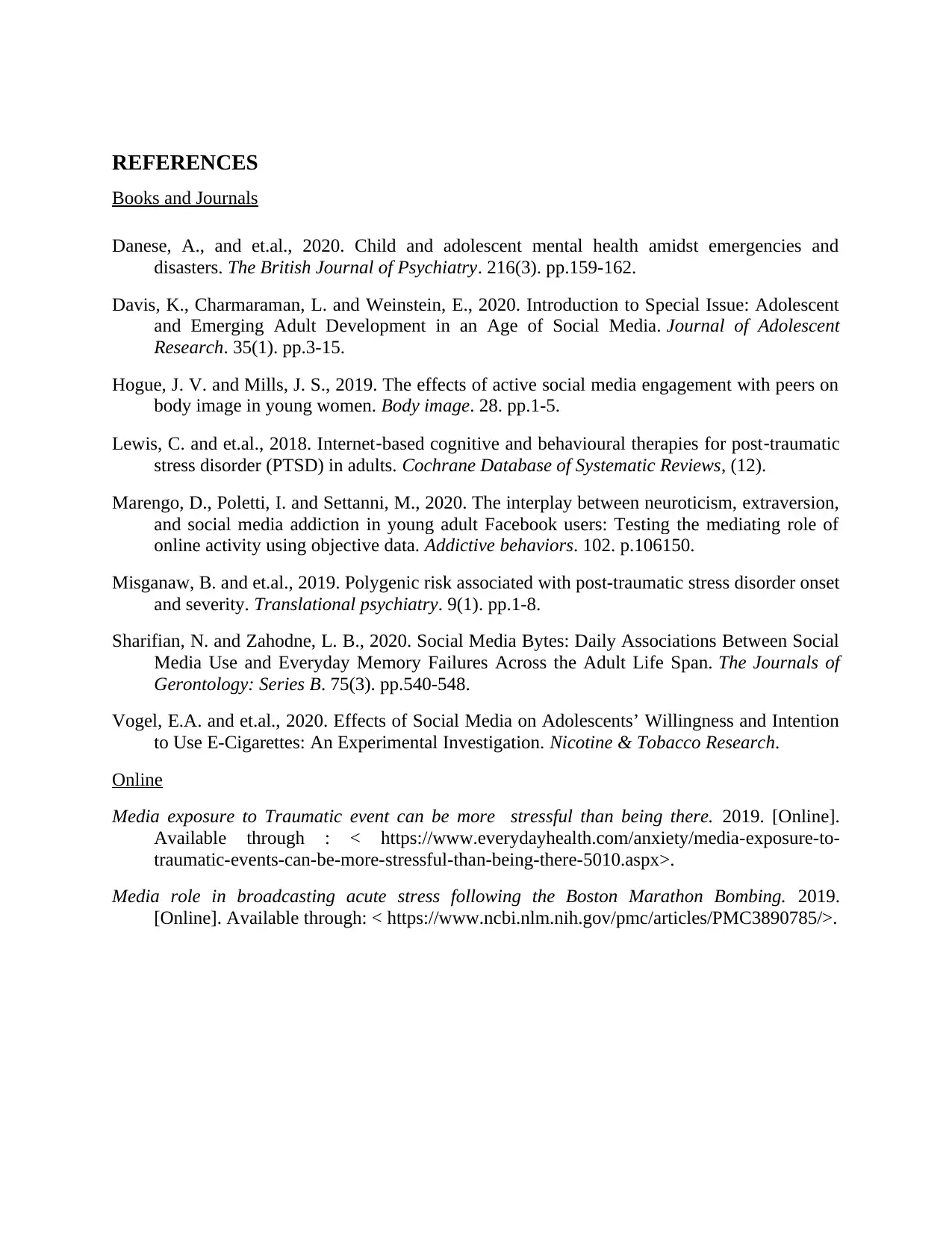
REFERENCES
Books and Journals
Danese, A., and et.al., 2020. Child and adolescent mental health amidst emergencies and
disasters. The British Journal of Psychiatry. 216(3). pp.159-162.
Davis, K., Charmaraman, L. and Weinstein, E., 2020. Introduction to Special Issue: Adolescent
and Emerging Adult Development in an Age of Social Media. Journal of Adolescent
Research. 35(1). pp.3-15.
Hogue, J. V. and Mills, J. S., 2019. The effects of active social media engagement with peers on
body image in young women. Body image. 28. pp.1-5.
Lewis, C. and et.al., 2018. Internet‐based cognitive and behavioural therapies for post‐traumatic
stress disorder (PTSD) in adults. Cochrane Database of Systematic Reviews, (12).
Marengo, D., Poletti, I. and Settanni, M., 2020. The interplay between neuroticism, extraversion,
and social media addiction in young adult Facebook users: Testing the mediating role of
online activity using objective data. Addictive behaviors. 102. p.106150.
Misganaw, B. and et.al., 2019. Polygenic risk associated with post-traumatic stress disorder onset
and severity. Translational psychiatry. 9(1). pp.1-8.
Sharifian, N. and Zahodne, L. B., 2020. Social Media Bytes: Daily Associations Between Social
Media Use and Everyday Memory Failures Across the Adult Life Span. The Journals of
Gerontology: Series B. 75(3). pp.540-548.
Vogel, E.A. and et.al., 2020. Effects of Social Media on Adolescents’ Willingness and Intention
to Use E-Cigarettes: An Experimental Investigation. Nicotine & Tobacco Research.
Online
Media exposure to Traumatic event can be more stressful than being there. 2019. [Online].
Available through : < https://www.everydayhealth.com/anxiety/media-exposure-to-
traumatic-events-can-be-more-stressful-than-being-there-5010.aspx>.
Media role in broadcasting acute stress following the Boston Marathon Bombing. 2019.
[Online]. Available through: < https://www.ncbi.nlm.nih.gov/pmc/articles/PMC3890785/>.
Books and Journals
Danese, A., and et.al., 2020. Child and adolescent mental health amidst emergencies and
disasters. The British Journal of Psychiatry. 216(3). pp.159-162.
Davis, K., Charmaraman, L. and Weinstein, E., 2020. Introduction to Special Issue: Adolescent
and Emerging Adult Development in an Age of Social Media. Journal of Adolescent
Research. 35(1). pp.3-15.
Hogue, J. V. and Mills, J. S., 2019. The effects of active social media engagement with peers on
body image in young women. Body image. 28. pp.1-5.
Lewis, C. and et.al., 2018. Internet‐based cognitive and behavioural therapies for post‐traumatic
stress disorder (PTSD) in adults. Cochrane Database of Systematic Reviews, (12).
Marengo, D., Poletti, I. and Settanni, M., 2020. The interplay between neuroticism, extraversion,
and social media addiction in young adult Facebook users: Testing the mediating role of
online activity using objective data. Addictive behaviors. 102. p.106150.
Misganaw, B. and et.al., 2019. Polygenic risk associated with post-traumatic stress disorder onset
and severity. Translational psychiatry. 9(1). pp.1-8.
Sharifian, N. and Zahodne, L. B., 2020. Social Media Bytes: Daily Associations Between Social
Media Use and Everyday Memory Failures Across the Adult Life Span. The Journals of
Gerontology: Series B. 75(3). pp.540-548.
Vogel, E.A. and et.al., 2020. Effects of Social Media on Adolescents’ Willingness and Intention
to Use E-Cigarettes: An Experimental Investigation. Nicotine & Tobacco Research.
Online
Media exposure to Traumatic event can be more stressful than being there. 2019. [Online].
Available through : < https://www.everydayhealth.com/anxiety/media-exposure-to-
traumatic-events-can-be-more-stressful-than-being-there-5010.aspx>.
Media role in broadcasting acute stress following the Boston Marathon Bombing. 2019.
[Online]. Available through: < https://www.ncbi.nlm.nih.gov/pmc/articles/PMC3890785/>.
1 out of 8
Related Documents
Your All-in-One AI-Powered Toolkit for Academic Success.
+13062052269
info@desklib.com
Available 24*7 on WhatsApp / Email
![[object Object]](/_next/static/media/star-bottom.7253800d.svg)
Unlock your academic potential
© 2024 | Zucol Services PVT LTD | All rights reserved.




